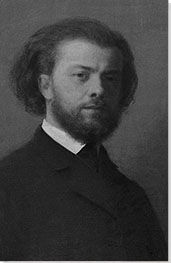Summary of Henri Fantin-Latour
Fantin-Latour is widely celebrated for a series of sumptuous, exquisitely detailed, flower pieces and still lifes. He produced many other important works however, notably several prestigious group portraits of contemporary artists and writers. His group portraits now stand as vital historical documents given that they brought together many key figures associated with the rise of the French avant-garde, including Ingres, Delacroix, Carot, Manet and Baudelaire. However, and though he was closely associated with the troupe, Fantin-Latour remained something of an outsider inasmuch as his own art had its roots in eighteenth-century Dutch Golden Age painting. Though an artist firmly rooted in the Realist tradition, he was still willing to explore a more expressive palette through his forays into mythical narratives based on important operatic works. In his late period, Fantin-Latour took his interest in opera further by bringing performance narratives to life through a series of finely executed lithographs.
Accomplishments
- Following early setbacks with his portraiture, Fantin-Latour turned his attention to floral still-life paintings. His earliest works were marked by a purity and easiness of composition. As he progressed, however, his still lifes became more complex and more finely detailed. Indeed, his eye for fine detail, which had hitherto distinguished his portraiture, was honed on still lifes allowing him to produce floral compositions of near photographic detail.
- Fantin-Latour continued to work in portraiture through which he finally established a second foothold in the market. He earned further recognition and prestige for his group portraits of fellow artists which drew praise for their outstanding virtuosity and fine brushwork. His portraits confirmed his relationship with other contemporaries, including James Abbott McNeill Whistler with whom he shared a close artistic affinity.
- Complementing his earlier work with groups, Fantin-Latour produced a number of refined "domestic" portraits. Rendered through a softly colored palette, and featuring family members and intimate acquaintances occupied in everyday activities, these portraits owed much to the style to the Dutch Golden Age and the eighteenth century French painter Jean-Baptiste Siméon Chardin.
- Though (rightly) renowned as a Realist, Fantin-Latour found success with more fantastical themes that would anticipate the conventions of Symbolism. His operatic and mythological narratives were rendered through effortless, poetic, brushwork and a more animated, multihued palette.
Important Art by Henri Fantin-Latour
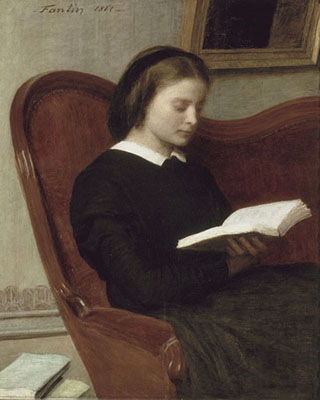
Woman Reading
Having had a self-portrait turned down in 1859, Woman Reading was the first of Fantin-Latour's paintings to be accepted into the Salon de Paris. He would usually choose his models from his family circle and the sitter in this portrait, one of the artists personal favourites, was indeed the artist's sister. In contrast to the impressionistic preferences of the burgeoning French avant-garde, Woman Reading took its lead rather from 18th century Dutch realist painting.
Painted in muted colors, the canvas shows a young woman absorbed in a book. The atmosphere and subject of the painting was inspired in fact by the work of eighteenth-century Dutch masters and his fellow countryman Jean-Baptiste Siméon Chardin who is best known for his domestic portraits including those of women engaged in everyday activities (such as sewing or weaving). Like Chardin, Fantin-Latour's women would be so engrossed in their activity that would appear oblivious to the artist's presence and to the spectator's gaze. In its exhibition notes on the painting, the Musée d'Orsay suggests that "The motionless model, the still life formed by the two books in the foreground, the subdued colours scarcely warmed by the reds of the sofa all contribute to the air of tranquillity and silence [...] It gives a foretaste of the sobriety, simplicity and severity that characterised [Fantin-Latour's] later portraits".
Oil on canvas - Musée d'Orsay, Paris
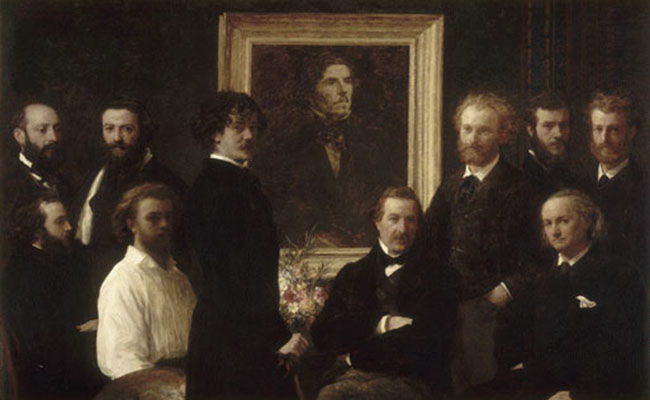
Homage to Delacroix
Painted a year after the death of Eugène Delacroix, Homage to Delacroix is an early example of the group portraits Fantin-Latour became so well known for. Still using a palette of muted earth tones, the artist has painted a group of ten gentlemen seated around a portrait of Delacroix (which is based on a photograph of Delacroix taken ten years earlier). Also depicted are: Fantin-Latour himself on the left in the white shirt and holding a palette; James Whistler standing next to him; Charles Baudelaire is seated with his arms crossed; and Edouard Manet, stands directly behind him.
Aside from promoting the artist's preferred colors, the work also shows how Fantin-Latour stayed true to his preference for Realism and a more academic style, despite being close to the most significant figures associated with the more radical art directions in Paris. The painting also provides evidence of his ability to use subtle changes in shade and tone to denote precise lines and the characteristics of his sitters. Although the work was not well received by progressive critics, Fantin-Latour was not swayed by the fashion for Impressionism and his portraits, now looked to as historical records, have stood up to scrutiny and the tests of time.
Oil on canvas - Musée d'Orsay, Paris
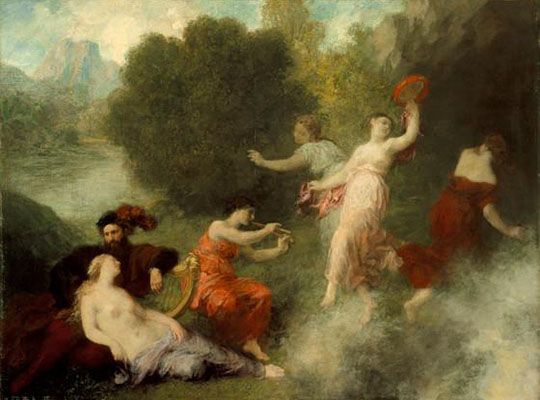
Tannhäuser on the Venusberg
Tannhäuser on the Venusberg is one of Fantin-Latour's earliest interpretations of contemporary operas, here Richard Wagner's controversial take on the frictions between profane and sacred love. The first of his three treatments of this opera, the image is taken from the first scene in which Tannhäuser has just arrived in Venusberg, the fairyworld ruled by Venus. He is surrounded by dancing nymphs and Bacchantes while Venus reclines across him. This is the moment leading up to the most scandalous part of the play in which Tannhäuser has an orgy with Venus and her nymphs.
This opera was a favorite of the Fantin-Latour (he went on to create a lithographic transfer of this painting in the 1870s, his first serious attempt at using this method). As a painting, and though rendered via a brighter color palette and looser brushstrokes than his portraits and still lifes, one can still detect his commitment to muted Realism in the figure of Tannhäuser. He is somehow placed outside the gaiety of the scene, shown in shadow and rather alone when placed against the pale bodies and pastel hues of his mythical companions. Fantin-Latour's dedication to working in his studio, led to some compositional flaws; the awkward relationship between the bodies being attributed to the artist refusal to work with landscapes.
Oil on panel - Los Angeles County Museum of Art
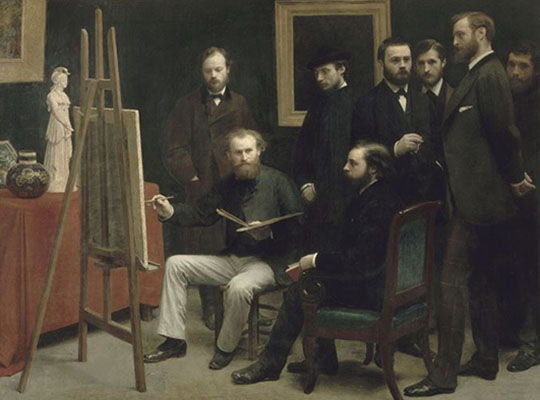
A Studio in Les Batignolles
Another example of Fantin-Latour's group portraits, A Studio in Les Batignolles is an homage to Manet, who is the central figure of the canvas. Sitting at his easel with a brush, and with palette in hand, Manet is shown as a mentor to the artists who observe him at work. They include German artist Otto Schölderer, writer Emile Zola, Claude Monet, Auguste Rodin, patron Edmond Maître, Zacharie Astruc, and Frédéric Bazille, all members of the Batignolles Group named after the area of Paris where the artists came together.
The work was in many ways Fantin-Latour's support for his friends who faced ridicule and lack of support from the art establishment and general public alike. Their dour expressions, and the sombre mood of the painting, was meant to lend the subjects an air of legitimacy as serious artists with legitimate aesthetic interests and concerns. This idea is supported through the objects on the left side of the canvas: the statuette of Minerva alludes to the respect the artists held for the classical world, while the Japanese vase is a reference to the importance of Japanese art, which has come to be recognized within art history under the umbrella of Japonism.
The work was exhibited in the 1870 Salon de Paris. It is ironic that a work that intended to defend artists at the height of the movement that posed itself as a rejection of the Academy was selected to be exhibited. However, regardless of meaning the painting itself is a fine example of Fantin-Latour's traditional style and abilities to balance complex compositions.
Oil on canvas - Musée d'Orsay, Paris
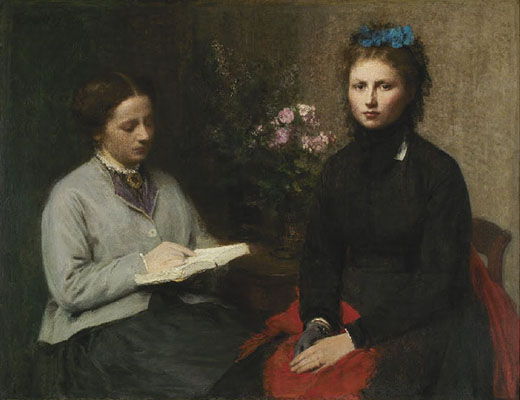
The Reading
In this work, the artist's future wife, Victoria Dubourg, is the reader. Her share of the canvas is dark which appears to support the illusion that she is lost or enraptured in or by the world of the book. On the right side of the frame sits Charlotte, Victoria's sister. Charlotte (who was at the time a house guest of her sister) looks directly at the artist with a palpable intensity. Her side of the frame is brightly lit and she seems to have almost materialized from the darkness that her sister occupies. On the one hand, The Reading provides another example of the artist's sombre sense of realism. On the other, the composition captures a poetic, almost dreamlike and melancholic mood. Indeed, the image carries connotations of domestic isolation carried in the mental separation between the two sisters.
While this work confirms the Fantin-Latour's mastery of light, color, and composition, the portrait remains perhaps most interesting for historians because of its element of romantic intrigue. Though Henri and Victoria were thought to be inseparable, and this painting was made at the very beginning of their 35 year relationship, the image would seem to add fuel to the rumour that Fantin-Latour and Charlotte were in a clandestine relationship. Charlotte appeared regularly in fact in Fantin-Latour's work leading some to speculate that the two were romantically involved. Here, the knowing look between artist and model could be interpreted as a sign that the rumours were not without foundation.
Oil on canvas - Calouste Gulbenkian Museum
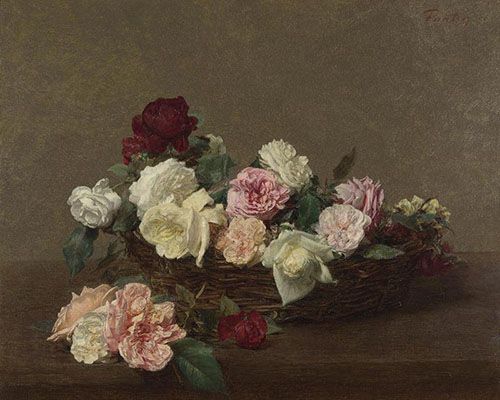
A Basket of Roses
Fantin-Latour received numerous commissions for his floral still lifes. He produced over 500 such compositions during his career, 100 of which were roses. In this example, the artist has painted a dozen-plus flowers placed in and around a wicker basket. Though they appear as if they have been tossed aimlessly, their positioning is in fact intentional. Presented in a way that vaunts Fantin-Latour's artistry, each item is arranged in such a way that the heads of the blooms emphasize their unique structure, coloration, and otherwise unique qualities.
A later example of the botanical series, A Basket of Roses also offers insight as to how the artist had refined his fine-detail technique. Rather than work from preparatory sketches, Fantin-Latour would only paint real flowers. However, given that the quality of the flowers would quickly diminish, Fantin-Latour called on a memorization technique he learned from Horace Lecoq de Boisbaudran. He also used a special produced canvas that allowed paint to dry faster. This allowed him to paint many layers quickly, as he painted to record nature at its most beautiful.
This work, like his other floral still lifes, was particularly suited to bourgeois Victorian tastes. The plain background and table surfaces allow the flowers to gain the full attention of the viewer while the uncluttered canvas allowed the paintings to stand out when exhibited besides more "busy" works. As the writer Emile Zola noted, "The canvases of M. Fantin-Latour do not assault your eyes, do not leap at you from the walls. They must be looked at for a length of time in order to penetrate them, and their conscientiousness, their simple truth - you take these in entirely, and then you return".
Oil on canvas - The National Gallery, London
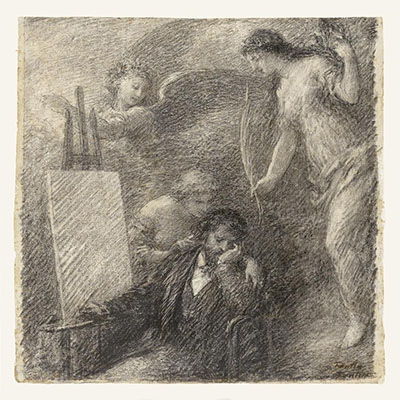
The Discouraged Artist
Complementing his more expressive "operatic" paintings, Fantin-Latour experimented with imaginative allegorical lithographs such as The Discouraged Artist. Although lacking a degree of professional finish, the artist signed the lower right corner of this drawing allowing the sketch to rank as a completed work. In the foreground we see an artist - possibly based on Fantin-Latour himself - sat next to a blank sheet. Though his hand holds a pencil, the artist is clearly disconsolate at his inability to find the stimulus to draw. Solace and inspiration arrives however in the guise of the three visiting angels. Since the work is an imaginative composition, and Fantin-Latour frequently engaged with themes of creativity, vision and inspiration, the three angels can be understood as embodiments of those three virtues, all of which were considered primary drives in the artist's inner life.
In addition to being a fine example of the artist's more imaginative side, this lithograph demonstrates how Fantin-Latour's subtle use of shade translated from one medium (painting) to another (lithography). Here, despite the lack of any clear delineation, there is depth and perspective, which the artist achieved in part by scraping away parts of the crayon. The lithograph thus confirms thus the artist's masterful understanding of tone and shade. Commenting on its thematic qualities, meanwhile, René-Marc Ferry wrote in 1904, that The Discouraged Artist showed that "When he found realism too limited and stifling, he lost himself in dreams".
Black lithographic crayon with scratching on tracing paper - Getty Museum
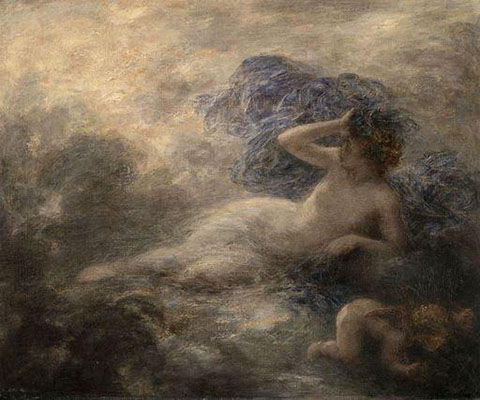
La Nuit
La Nuit is one of Fantin-Latour's later paintings, and one for which he garnered significant critical approval. It is in keeping with his earlier operatic paintings but here the work comes, not via Wagner, but purely from the artist's imagination. Painted with free, fluid brushstrokes, and with a delicate, light palette, the central figure of La Nuit is a reclining female nude whose sensuality symbolizes the night (La Nuit). An angel can be seen in the lower right corner looking out beyond the edge of the canvas; his red wings, coupled with the female figure's (possibly concerned) expression, lend the painting a mysterious quality. The background is nondescript, contributing to the otherworldliness of the work. Indeed, the caption in Fantin-Latour's exhibition catalogue, organised by the Galeries Nationales du Grand Palais in Paris in 1982-83, read as follows: "On the left side of the painting, he uses light effects to create an area of abstraction, with no formal structure or definition, similar to a Turner painting or Monet's Thaw, whereas he paints the mist with streaks of blue, carmine and yellow mixed directly on the canvas, just like Renoir ".
The painting is in fact a slightly darker version of an 1895 painting of the same name which was also critically acclaimed (possibly prompting Fantin-Latour to produce a second, more refined, version). The work demonstrates Fantin-Latour's willingness to move beyond the realms of realism and to engage with the poetic and sensuous traits of Symbolism. Such was the painting's quality, it was purchased for the State of France and on its presentation at the 1897 Salon the critic Gustave Geffroy cooed: "Night: no woman ever lay more softly, in a painted heaven, enveloped in waves of soft clouds".
Oil on canvas - Musée d'Orsay, Paris
Biography of Henri Fantin-Latour
Childhood and Education
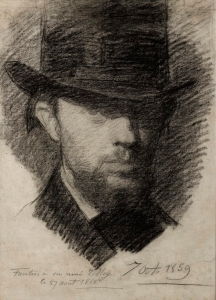
One of three children, Henri Fantin-Latour (née Ignace Henri Jean Fantin-Latour) was born to a Russian mother and the French portrait painter and drawing tutor, Theodore Fantin-Latour. At the age of 5, he and his family moved to Paris, where he began to study drawing under his father's tutelage. Later, between the ages of 14 to 18, he studied with the artist Horace Lecoq de Boisbaudran, who was known for having his students observe works on display at the Louvre and then attempt to reproduce them from memory.
Although he undertook brief spells in 1854 at the École des Beaux Artes, where he first met lifelong friends and future collaborators, James Abbott McNeill Whistler and Alphonse Legros, and a time working in Gustave Courbet's studio, most of his time remained dedicated to copying works at the Louvre. He focused on reproducing Old Master paintings, and throughout much of his early career, he earned a living from these copies. He also met Edouard Manet, Berthe Morisot , Edgar Degas and Victoria Dubourg (his future wife) while practicing at the Louvre.
In the mid-nineteenth century Paris was considered the epicentre for artistic creation and aspiring contemporary artists gravitated towards the French capital. Fantin-Latour, Legros and McNeill Whistler were amongst this group of hopefuls though, in an environment when the individual and individual expression was sacrosanct, they decided to form the Société des trois. The three colleagues adhered to a set of artistic principles that helped in their transition from amateur to professional status. The Société des trois lasted roughly ten years (between 1858 and 1868) before each artists was established enough to make their own way.
During his early career, Fantin-Latour mostly painted self, and family, portraits. Having had one of his portraits rejected by the Salon de Paris in 1859, he turned his attention to still-life painting. Persuaded by Whistler to visit London, Fantin-Latour found his new still lifes, painted in a highly realistic manner, were particularly appreciated. In London he also met Edwin and Ruth Edwards, who would become life-long friends and patrons. The artist did not have to wait long to be appreciated in his home country either. His first exhibited at the Salon de Paris in 1861 and then at the Royal Academy (in London) in 1862. A year later, and although his work tended to be academic in style, he exhibited with the likes of Paul Cézanne, Camille Pissarro, Whistler and Edouard Manet, at the famous Salon des Refusés, an exhibition that did so much to announce the Impressionists.
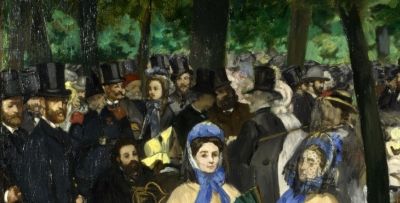
Once back in Paris, Fantin-Latour spent most of his time with a close knit artistic circle who met regularly at the cafes on the Boulevard St. Germain. He spent many hours at Manet's studio and painted a number of portraits of the artistic community there (Manet would reciprocate by featuring Fantin-Latour and others from the group in his painting Music in the Tuileries). However, despite his vibrant social circle, Fantin-Latour remained something of an outsider and as he grew older he spent less and less time at the artist cafes, preferring to spend time on his older friendships. Fantin-Latour's art entered its mature phase around the mid-1860s and early 1870s. Having changed his social circle, he began to experiment purposely with lithography (having learned the technique from Whistler's brother-in-law) and mythological scenes and works inspired by operatic scores.
Mature Period
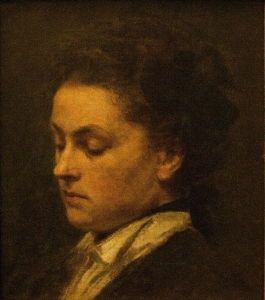
Fantin-Latour's mature period coincided with great personal change. He had long felt that he was immune to the joys of love. Writing to Whistler in 1866 he told his friend: "I feel very little affection for women [...] They frighten me and I do not like them". Artist and writer Elizabeth Kane has conjectured that this disaffection likely took hold in 1867, a year in which he lost his mother. Her death coincided with the "loss" of his two sisters; the first married a Russian general and was never to be seen again; the second became institutionalized. Kane has suggested in fact that he transferred his love for women onto the portraits of his female sitters.
Fantin-Latour's attitude changed when, in 1869, he met and fell in love with fellow still-life painter Victoria Dubourg. Despite being all-but inseparable, the couple were compelled to wait until 1876 to be married. This prolonged engagement was a result of Fantin-Latour's duty of care towards his aging father and his institutionalized sister. Once his father has passed, however, Fantin-Latour, (having collected his inheritance) was financially equipped to support his wife. The couple would spend every summer on Victoria's family's estate in Normandy. The Normandy climate allowed for different sorts of flowers to bloom which afforded Fantin-Latour an opportunity to expand the scope of his still-life subjects. The marriage also meant that he was able to join Dubourg's close family circle which went some way to alleviate his feelings of loss.
Late Period
Though he continued to paint still lifes, from 1876 onward Fantin-Latour began more and more to explore the possibilities of lithography which he used to illustrate both works by his favorite composers and mythological scenes. That same year he exhibited one of his lithographs at the Salon to great acclaim. His standing as an artist was officially recognized when he was awarded the Legion d'honneur medal in 1879. He consistently exhibited his lithographs until the end of his life, vowing in 1901: "Never again flowers or portraits. I amuse myself painting whatever comes to mind and, happily, have a dealer who buys whatever I do".
Little is known about the end of Fantin-Latour's life. The couple settled in the apartment above Henri's studio, and lived there for the rest of their lives. The studio was described by artist Jacques-Emile Blanche as "a sort of wooden barn, painted red, white, and blue which Degas described as Fantin's Orleanist tent, though he was a republican, anticlericalist and antimilitarist". The couple did not have children, and what is known emphasizes a contented and sociable existence. The couple continued to summer in Normandy annually and it was there that Henri passed away in August 1904 (Victoria surviving him by 22 years).
The Legacy of Henri Fantin-Latour
Fantin-Latour remains one of the most recognizable French Realist painters of the 19th century; so well-known in fact that a type of Centifolia rose is named after him. He had a profound impact on his friends (despite not being an Impressionist) such as the portraits of Alphonse Legros who followed Fantin-Latour's dark, realist style. He can also be seen as an influence on the early works of artists such as Gustave Caillebotte. One might also argue that his mythological works laid the foundation for the Symbolists with Odilon Redon citing him as an influence.
His legacy within broader culture was most strongly felt in Britain, where he held considerable prestige as a Victorian era painter. Marcel Proust included mention of his work in his book In Search of Lost Time while more recently his art has reached a new generation by featuring on the cover of Power, Corruption & Lies, the 1983 best-selling album by the British band New Order.
Influences and Connections

-
![James Whistler]() James Whistler
James Whistler -
![Édouard Manet]() Édouard Manet
Édouard Manet -
![Berthe Morisot]() Berthe Morisot
Berthe Morisot - Victoria Dubourg
-
![Édouard Manet]() Édouard Manet
Édouard Manet - Victoria Dubourg
Useful Resources on Henri Fantin-Latour
- Fantin-Latour: A fleur de peau (exhibition catalogue, in French)By Laure Dalon, Xavier Rey, Bridget Alsdorf, Laurent Salome, and Leila Jarbouai
- The Art of Henri Fantin-Latour: His Life and WorkOur PickBy Frank Gibson
- Fantin-LatourBy Michelle Verrier
- Fantin-Latour: ExhibitionOur PickBy Douglas Druick and Michael Hoog
- Fellow Men: Fantin-Latour and the Problem of the Group in Nineteenth Century French PaintingOur PickBy Bridget Alsdorf
